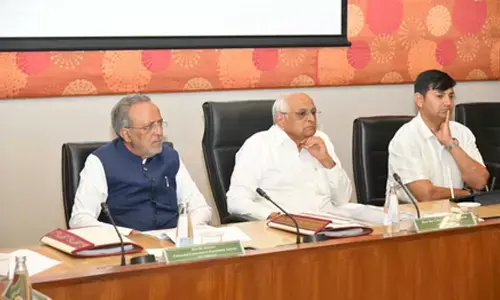Chinese in no mood to pull back

Chinese in no mood to pull back
The 13th round of Corps Commander level talks between India and China ending at an awkward note, was not a surprise to anyone, analysing Chinese activities and signalling prior to the talks.
The 13th round of Corps Commander level talks between India and China ending at an awkward note, was not a surprise to anyone, analysing Chinese activities and signalling prior to the talks. The talks happened against the backdrop of recent incidents of intrusions by Chinese troops in the Barahoti sector of Uttarakhand, Tawang sector of Arunachal Pradesh, heavy concentration of troops and modern arsenal along LAC, exercises and building permanent structures in areas which China had encroached in April 2020, vacation of which was the main purpose of the talks.
It was, therefore, amply evident that China was in no mood to concede anything and went through the talks for optics of ongoing talkathon. Post disengagement of troops in Eastern Ladakh from North and South of Pangong Tso, some disengagement in Gogra, no disengagement in other areas to include Depsang plains, Hot Spring, Demchok, and no de-escalation, was therefore, a forgone conclusion.
The Chinese intention to coerce India to resume business as usual, sidelining border/LAC issue and not insist on further pull back was refuted by the India earlier when it conveyed that disengagement at all friction points leading to de-escalation, peace and tranquility on borders are prerequisites to progressing smooth bilateral ties. This rightful Indian stance to get back to pre-April 2020 positions stands adversely affected by Chinese obnoxious allegations of "India pushing for unreasonable and unrealistic demands, which is creating difficulties in negotiations," which indirectly conveys no more pulling back. In the recent past almost 80 per cent of Chinese top leaders, including President Xi Jinping have visited Tibet/Xinjiang. Massive infrastructure development in terms of airstrips, rail, road network to border towns like Nyngchi, accommodation and other activities are worth monitoring for India to strategise its responses.
Chinese political aim was and continues to be China-centric Asia and forcing Indian subordination, a necessity to achieve it. This aim could not be achieved despite prolonged standoff in Ladakh so far, but will remain unchanged, even in future. Chinese strategic aim to control Eastern Ladakh was to provide depth to its National Highway G-219, Karakoram Pass, redraw Line of Actual Control (LAC) as per its perception (1959-60) and negotiate border on its terms thereafter. China can claim to have partially achieved it, with continued presence in extra kilometrage in Depsang plains, Hot Spring, Demchok areas, where disengagement hasn't taken place. Having developed its infrastructure in areas as per its perception of LAC, its aim to deny the same to India has not been so successful, as India continues to develop its infrastructure at unprecedented speed to catch up, in recent past.
The Indian aim has been to get Chinese back to pre-standoff positions as of April 2020 in all friction points, not to concede unilateral change of LAC, and pursue talks towards its demarcation, hoping to lead to border resolution. With current disengagement, status quo stands achieved in areas north and south of Pangong Tso, albeit at the cost of losing the crucial leverage of giving up occupation of certain heights on Kailash range and north of Pangong Tso, prior to Chinese vacation of 'Other Areas'. Pursuing disengagement and de-escalation in remaining areas will be an uphill task due to shortage of leverages, given Chinese past track record and recent activities.
The Indian planners will find it difficult to explain why disengagement was not sequenced on 'first in and first out' basis?, meaning thereby that India should have vacated Kailash Range heights only after China had vacated all the areas, where it advanced in Depsang plains, Gogra, Hot Spring and Demchok areas, since April 2020, despite being pointed out by many strategic analysts. It is reasonable to believe that it has left India at a disadvantage, due to shortage of leverages and no worthwhile saving in financial and human cost, as no de-escalation has taken place. Notwithstanding the political debates over the legacy of Depsang issue, it remains strategically important and a threat to DBO and DS-DBO Road; hence a concern for India.
Unlike all major powers, India does not have a National Security Strategy (NSS) in open domain to steer capacity building to take on China's challenge in a synergised manner. The reactive actions of India over several decades indicate diplomacy-driven "Don't annoy China Approach," which has failed miserably as China gave no concession on displaying accommodation so far. Not calling out Xinjiang or Hong Kong by India did not prevent China from dragging India to UNSC on Kashmir issue or not progressing CPEC on Indian sovereign territory.
In absence of not even stating our challenges, expecting different agencies to synergise in capacity building to take on Two-Front challenges seems far-fetched. India needs to formulate its NSS, prioritise its challenges and task required agencies to develop capacities.
Indian aim should be not to concede Chinese attempt to redraw LAC as LAC-2020, because a temporary solution/side-lining main issue is a recipe for the next standoff, leading to LOC-ization of LAC further. The Chinese would like to keep the border unsettled, till the time the political cost of not settling it becomes higher than doing so for CCP, China.
India must be prepared for 'Two Front War' as a worst case scenario, and continue capacity building in all domains, including maritime domain, where Chinese vulnerable sea lines of communications can be threatened. Besides ongoing infrastructure development along borders it is recommended that States/UT along LAC should allot concessional land to security forces like regional SCOUTS, ITBP, SSB, and families hailing from that area (on son of soil concept), ready to settle in villages so constructed, along own perception of LAC. This will improve inclusive growth, integration, besides proof of our claims on the border, to ward off Chinese design of developing hundreds of new villages along LAC. The best way to avoid a two-front war is to convince both adversaries that India can fight it, backed by appropriate capacity building and intent to use all instruments of power.
Strategic partnerships with like-minded democracies and collective naval posturing to create a multifront situation for China are efforts in the right direction. There is a need for an alternative supply chain, trade and technological ecosystem, independent of China for which some initial steps taken by Quad countries need to be pursued. India needs to develop its strategic culture with professional strategists, as diplomacy driven patch ups and talkathon hasn't worked so far. The overall strategic approach has to be proactive at tactical, operational as well as strategic level.
(Maj Gen SB Asthana, SM, VSM (Veteran) is Chief Instructor, United Service Institution of India. The views expressed are personal)














